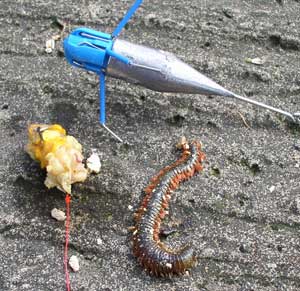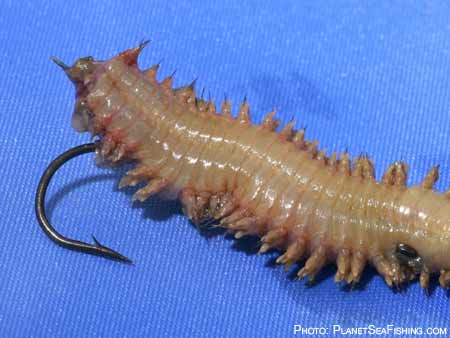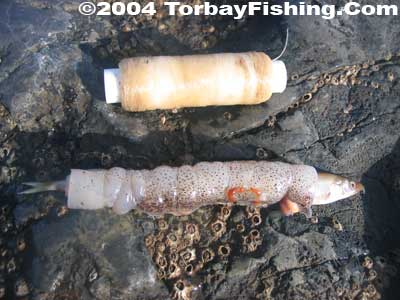The Beginner's guide to shore fishing
Part Two - Baits
By Simon Day.

The bait
There are a number of choices for bait, these include:
- Mackerel Strips
- Rag Worm
- Lug Worm
- Peeler Crab
- Sand Eels
- Live Prawns
- Squid
The bait will depend on the type of fishing you'll be doing and the season. Most can be used on either float or on the bottom.
If you're just starting out I would suggest getting some mackerel and float fish on mackerel strips to catch mackerel. You then have spare bait in the freezer so if you fancy going out one night and everywhere is closed.
I always try and keep half a dozen mackerel frozen for those "all the tackle shops are closed" moments. For float fishing the most common baits are mackerel strips, rag worm, sand eels and squid. For the bottom the most common are rag worm, peeler crabs and squid.
[ Back to Top ]
Setting up mackerel
Need help on how to catch mackerel? Visit my "How to catch mackerel guide".
Once you've caught your mackerel you need to kill it and set it up for bait. What is really cruel is leaving a fish to die in a bag or beside you. It takes a long time and makes them really suffer. A more humane way is by using the following method:
Place your thumb behind the head and place your index finger inside the mouth. The teeth cannot hurt you so you are safe doing this. You now pull the head back towards its body. You will snap its neck which will instantly kill it.
How to fillet and use as bait
Watch this video to see how to fillet the mackerel correctly:
So it should end up something like this:

Where to place the hook
Click the image below to see where to cut and where to place the hook
The reason you use the patterned part of the mackerel to place your hook is because that is where the strip is the toughest.
[ Back to Top ]
Setting up peeler crab
We are now reaching a bait which a lot of people won't use because of the time involved adding it to a hook. The rewards are well worth the extra effort and cost (around 70p per crab). Peeler crab are loved by many of the more rarer fish and if you're fed up catching mackerel, garfish etc and want to try for bigger and better fish then peeler crab really is a bait worth all the extra hassle. A lot of people like me use combo's which in include peeler in the mix.
First off you remove the legs, claws and shell so it looks something like this:

Now you have a few options. You can cut it in half (through the middle with the legs on either side) so you have 2 pieces of bait.
You could also cut it half way along (again with the legs on either side of the cut) and then straighten it out so you have a sausage shaped bait that will slide better on the hook and it will also leave the tip of the hook more exposed.
You'll notice this bait is very soft and feels like it will come off when you cast. It will so what you need is some bait elastic (see pic below)

You now tightly wrap the elastic string around the crab half a dozen to a dozen times BUT make sure the hook is not obstructed in anyway! If you can't see the hook then the fish won't get hooked! Your final bait should look something like this:

It's best to use this bite when it's live. You can tell the crab is ready when the shell is very loose or already off. If the shell is still firmly attached then you'll need to tap it with the butt of your knife or something similar so it cracks. you then peel the pieces off.
The lungs (orangey yellow colour inside the crab) are poisonous and a lot of people remove the lungs before they attach it to their hooks. It's up to you if you want to do this or not. I've been told if you freeze crab the lungs tend to turn black so this is why people remove them before freezing. I've personally not noticed any difference leaving the lungs on or off when fishing.
[ Back to Top ]
Setting up ragworm
Ragworm are a great bait and most fish love them!

Worms have 2 pincers so you need to be a little careful when preparing them. If you're a lightweight :) you can cut off the head which does then give a better blood trail but it won't be as secure on the hook. I would personally keep the head on. It stays on MUCH better if you hook through the mouth.

Place the hook through the pincers.
You have a few options on how to prepare the bait. The best advice I can give is don't be stingy with the bait. I will often feed 2 to 4 rag through the hook and up the line to give a much greater scent and visual trail for the fish.
*top tip*
Before you cast your hook full of rag worm dip them in sea water. Rag worm can come off the line easily and by dipping them in some water just before you cast reduces the loss.
You can feed through half the worm and leave the rest trailing and if you do this you will need to hook into the worm again so it's more secure on the hook. You need to watch when you cast carefully because if you cast too hard there is a good chance the ragworm will fly off the hook (another reason why having more than one on a hook is a good idea. What I tend to do is once the rag(s) on are the hook I finish off with a small piece of mackerel or squid to limit the chances of the worm flying off the hook.

Feed the ragworm up the hook and up the line.
If the photo above you will see that the ragworm has been fed up the hook so the hook is at the bottom of the worm. You can also have the hook stop at the middle of the worm as well. If you're casting long distances then having the worm fed fully will help it keep on the hook when casting.
Now the downside to worms are that the really small fish also love them and they can always seem to find a way of removing the worm without hooking itself. It is not uncommon to start having bites on worm milliseconds after it hits the water. The problem is the fish attacking them are so small they can't hook onto the smallest of hooks. Best advice if you're finding the worm being eaten instantly with no hookups is to cast a little further out or add more than one rag and hope you cast past the small stuff or the larger fish take the larger bait first.
Another good idea is to use a mix. Feed a worm or two through the hook and up the line and then finish with a piece of mackerel or squid for example. This does help to preserve your bait a little longer.
[ Back to Top ]
Sand eel top tip!
Like using sand eel but don't like it breaking off all the time? Do you also like using squid as bait?
Top tip then. Combine the two!

Take the head and tail off the squid and put them to one side for later bait. Now slice from top to bottom of the squid so you have a square, flat piece of squid. Now cut that length ways so you have 2 even pieces of squid to wrap around a sand eel.
Now all you do is cover the sand eel with the piece of squid and use some elastic to secure the squid to the eel. What I normally do is leave a piece of squid at the bottom free so it can flap about in the water.
You'll find that this bait will go nowhere and will last ages. Crabs can't decimate it and best of all I've found the fish love it!
Beginners Guide » Page 3 (accessories & care)
Help support this site!
If you value the information on this site then please help support me with the large running costs.
Recent Donations, thank you! £5.00
If this page didn't help you please, please, please email me here and tell me what you wanted on this page. I can add whatever it is you think was missing!
Beginner's guide to sea fishing
Also see - Common fishing knots (videos)
- How to tie a lock blood knot (Popular)
- How to tie a clinch knot (Popular)
- How to tie an Albright fishing knot to join two lines together.
Latest guides added
- How to fish from a pier
- How to unhook swallowed hooks
- South West fishing seasons - what you'll catch
- How to catch Mackerel using lures, feathers & floats
- How to catch cod
Also see...
- Fishing training in Torbay, Devon.
- How to set up fishing rigs
- How to fish from a pier
- Sea fishing seasons
- How to set-up a float for fishing
- How to tie a clinch knot (commonly used)
- How to tie a lock blood knot (commonly used)
- How to tie an Albright fishing knot to join two lines together.
Am I missing something? Please contact me to suggest an addition to these guides. Help me to help you!
[ Back to Top ]


